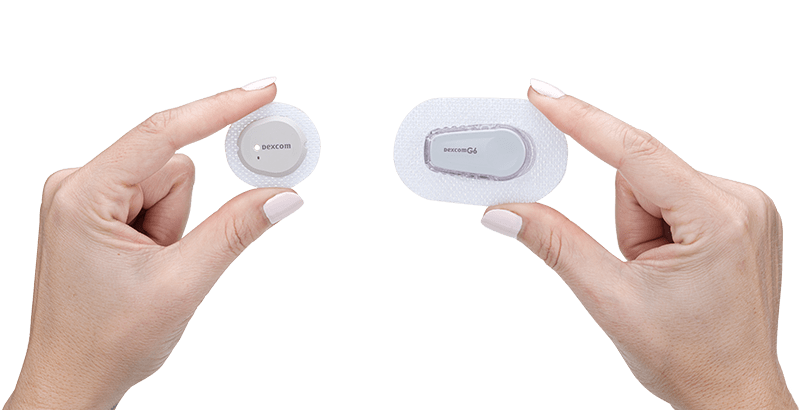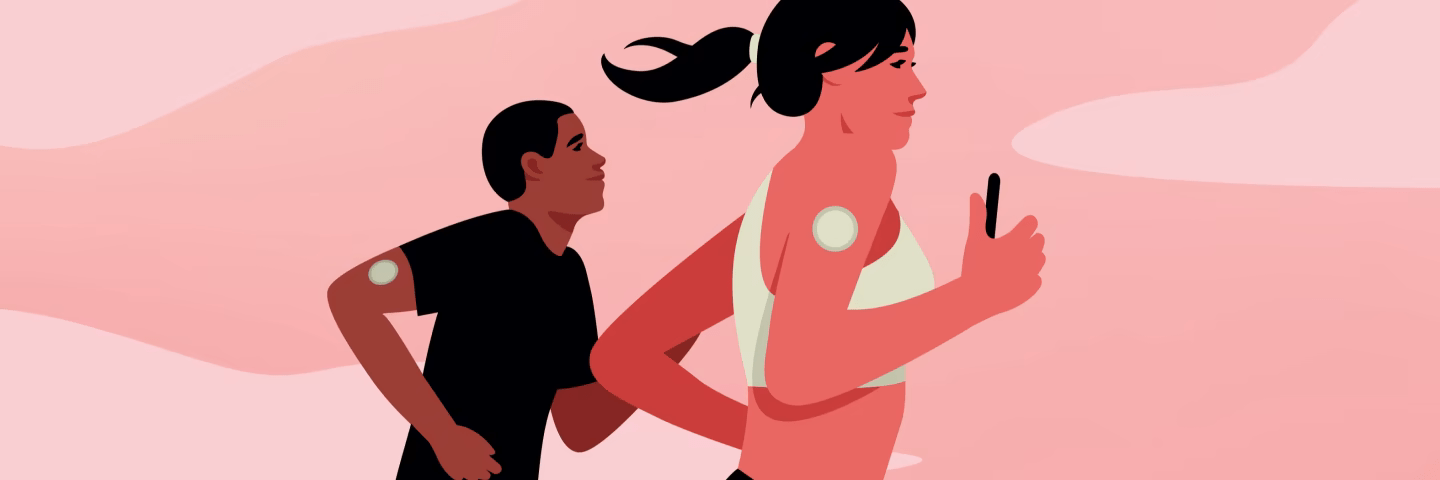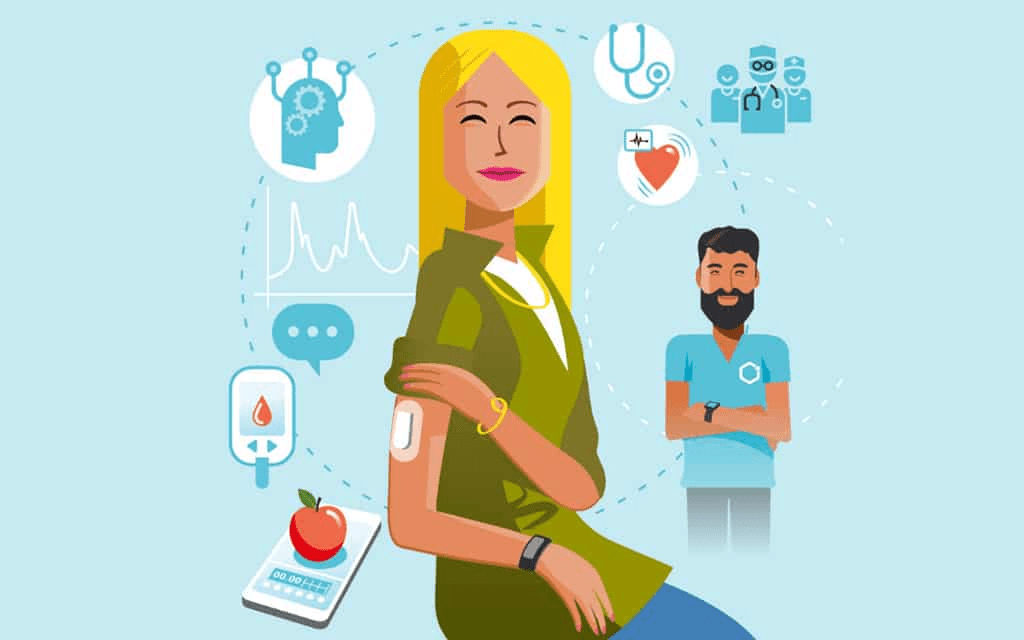How Effective Continuous Glucose Monitoring Systems Are?
Houston Endocrine Center2022-09-28T14:34:55+00:00The role of continuous glucose monitoring (CGM) systems in the management of diabetes are undeniable. But how effective continuous glucose monitoring systems are? The truth is, it is hard to know exactly what they can do because most of the studies were done on very large populations. The limited amount of research on the subject makes it almost impossible to determine exactly how much better CGM systems are compared to traditional blood glucose testing methods.

Source: VectorStock
If you are watching your blood sugar levels and taking medication for it, you may want to ask yourself how effective these systems actually are. Going by the numbers alone, continuous glucose monitoring systems looks pretty promising. But what happens when we look at some hard facts?
What Are Continuous Glucose Monitoring Systems?
Continuous Glucose Monitoring Systems are a great way to monitor your blood glucose levels throughout the day. They give you accurate updates on your glucose levels, and they can help you adjust your insulin dose accordingly.
You can use continuous glucose monitoring systems to adjust your insulin dose if you are having problems with your diabetes. These devices are worn around the wrist or stomach and provide real-time data about blood sugar levels. They usually come in the form of a small transmitter that is implanted under the skin, often in the shoulder or abdomen.

Source: VectorStock
It detects changes in glucose levels every few minutes and sends them to a reader for analysis. A finger-stick sample of blood is also collected at regular intervals and sent to the reader for analysis. The CGM monitor then displays the results on its screen, which glucometer strips or handheld devices can check. CGM monitors are very accurate in measuring blood glucose levels and have replaced older methods such as finger sticks twice daily (FBS), and finger sticks every 1-2 hours (FSIG).
The system also monitors trends over time so you can see how fast or slow your sugars are rising and falling over time. These trends can help determine whether or not you are producing enough insulin and controlling your diabetes properly so that it does not get worse over time.
Why Use CGM?
There are many reasons why we use CGM. Here are just a few:
- To help you understand your glucose levels better. You can see how they change throughout the day and night, which is helpful in planning meals and snacks.
- It improves glucose control in people with type 1 diabetes and those with poorly controlled type 2 diabetes.
- To help you manage your blood sugar levels when you have diabetes. The goal is to keep your blood sugar levels between 70 and 140 mg/dl (4.4 and 7.7 mmol/l), but this isn’t always easy to achieve with diet only. By using CGM, you can get more accurate information about how well you are managing your diabetes, which will help give you a better understanding of what works best for you to keep your blood sugar in check over the long term.

Source: VectorStock
- To help make it easier for people who have type 1 diabetes (T1D) to live full lives with no complications related to their disease. When someone has T1D, their bodies produce little or no insulin; therefore, it is important for them to monitor their blood glucose levels regularly throughout the day so they know when they need to take insulin or eat something with carbohydrates so that their body has enough insulin available to control their blood glucose levels properly.
- It can help prevent hypoglycemia (low blood sugar) and hyperglycemia (high blood sugar), which occurs when a person eats quickly or doesn’t feel the symptoms of low blood sugar in time to eat something more suitable for the body’s current needs, like fruits and vegetables.
- To help with weight loss as part of a healthy lifestyle program. CGM helps people better understand their bodies and how they react to different foods and activities so that they can make healthier choices for themselves without sacrificing enjoyment or convenience (which is what makes these programs so popular).
Benefits Of Using A CGM System
The benefits of using a CGM system are many. One of the most important ones are:
- It allows you to track your glucose levels in real-time. It can show you trends over time. You can check how your body responds to different foods, exercise, and other changes in your life. It can also tell you how much food you need to eat to keep a steady blood sugar level.
- You can also see the effect of certain drugs or supplements on your glucose levels. You can even monitor how different foods affect your blood sugar level. This information can help you make better food choices and take better care of your health.
- The system can be used anywhere, anytime, without worrying about losing the sensor or having it disconnect from the device during use or when removing it from one’s body or clothing.

Source: VectorStock
- Another benefit is improved self-management. If you know your glucose levels at certain times in the day, for example, it’s easier to stay within target ranges when eating and exercising. This could provide you with more flexibility in managing your diabetes and potentially improve the quality of life for people with type 1 diabetes.
- The device alerts users when their glucose levels are too high or low, which makes it easier to manage diabetes. Studies have found that CGM systems can reduce the risk of complications related to diabetes by up to 50%. This includes cardiovascular disease, nerve damage, eye damage, kidney failure, foot ulcers (bed sores), graft versus host disease (GvHD), infections, and death from diabetic ketoacidosis (DKA).
How Effective Continuous Glucose Monitoring Systems Are?
Continuous glucose monitoring systems are extremely effective in helping people with diabetes manage their blood sugar levels. They can help you control your blood sugar, which helps prevent complications from diabetes.

Source: VectorStock
You can use a continuous glucose monitor to test your blood sugar at home every three hours. This will allow you to check whether your insulin is working properly and give you an idea of how much more insulin you need. It also eliminates the need for finger sticks between testing, making it easier to test multiple times during the day.
The device itself is easy to use and comes with an easy-to-read display that shows you how much insulin you need based on your current blood sugar level. You can also use the device to record other information such as weight, activity, and hydration levels.
How Can You Find The Most Effective Continuous Glucose Monitoring Systems?
The most effective continuous glucose monitoring systems are the ones that are simple, accurate, and easy to use. It should also handle any type of blood sugar test, including ones requiring multiple measurements in a single day.
The most effective continuous glucose monitoring systems will have a wide range of user-friendly and easy-to-understand functions. It can be used by people with diabetes who are new to the technology or those who may have difficulty reading their monitors manually.
A good continuous glucose monitoring system will provide users with data to track their health and prevent hypoglycemia (low blood sugar). It should also help them manage their diabetes through diet and exercise routines.

Source: VectorStock
Accuracy And Reliability Of Continuous Glucose Monitoring Systems
The accuracy and reliability of continuous glucose monitoring systems are important to consider. However, the continuous glucose monitoring systems are accurate, reliable, and easy to use. Accuracy refers to how closely the device’s readings correspond with the actual glucose levels in your blood. Reliability refers to how long a device can be used before it needs to be replaced or repaired.
Accuracy is an important factor for people with diabetes because they need their blood sugar levels to be as close as possible to those of healthy individuals. A sensor that consistently provides inaccurate results can lead patients to eat foods or take medications that are not appropriate or possibly even cause them stress over the results.
Reliability is also important for patients with diabetes because they may need repeated readings throughout the day, including before meals and at other times when blood sugar levels may vary from one reading to another. For example, suppose you have a high-carbohydrate meal after lunch but don’t test your blood sugar until dinner time. In that case, your glucose levels could still be elevated due to some insulin action during the afternoon hours (although this is not common).
What Are The Factors That Effect The Accuracy Of Continuous Glucose Monitoring Systems

Source: VectorStock
The accuracy of continuous glucose monitor is a matter of great concern to many people. While there are many factors that affect the accuracy of a CGM system, one of the main reasons for inaccuracy is the sensor itself. The sensor is able to measure glucose levels only if it is in contact with the blood sample. If there is no contact between the CGM and blood sample, then the readings will be inaccurate.
The biggest drawback with this problem is that it can occur even when you wear your CGM device properly. In fact, many people have reported that their CGM devices get detached from their skin due to sweat or even skin creases. This leads to inaccurate readings, which can sometimes lead to serious complications such as diabetic coma or hypoglycemic events (low blood sugar).
To prevent this problem, you need to ensure that your CGM device has been fitted correctly on your arm or leg and that it has been placed in an area where there is no movement from other parts of your body, such as the arms or legs. You should also try wearing it under clothing rather than just covering it with a shirt or sweater since sweat will still cause problems for your CGM sensor.
Standard Vs. Pro Continuous Glucose Monitoring Systems
There are two types of continuous glucose monitoring systems: standard and pro. Standard continuous glucose monitoring (SCCM) systems transmit data every 5 minutes, while professional continuous glucose monitoring systems transmit data every 30 seconds.
Standard Continuous Glucose Monitoring Systems
Standard continuous glucose monitoring systems also allow users to receive alerts when blood glucose levels reach dangerous levels. These systems are the most commonly used and come in two different forms: pre-insertion and post-insertion. Pre-insertion systems are worn on the body, while post-insertion systems are worn on the arm or leg. They measure glucose levels throughout the day, sending results to a receiver via Bluetooth technology or a wirelessly connected sensor.
The downside of these devices is that they require frequent calibration and cleaning, which can be difficult for patients who need help bathing or moving around. In addition, some users find them uncomfortable because of the way they’re attached to their bodies — often wrapped around their upper arm — which can limit movement during sleep or other activities.
Pro Continuous Glucose Monitoring Systems
These devices are typically worn on the arm or leg and measure glucose levels every five minutes, tracking data over longer periods of time than standard continuous glucose monitoring systems (20 hours). Users can also receive alerts if blood glucose levels reach dangerous levels. Pro continuous blood sugar monitoring systems use a small sensor that is inserted into a vein and transmits data wirelessly via Bluetooth technology or radio frequency (RF) signals to a receiver device carried by the user. These receivers can be worn on clothing or attached to a belt for convenience during testing times.
4 Most Effective Continuous Glucose Monitoring Systems
Anytime you get the chance to improve your health and wellbeing, it’s a good idea to do so. That is why continuous glucose monitoring systems are becoming more popular than ever. The most effective continuous glucose monitoring systems are those that have a long battery life, a large number of sensors, and the ability to alert you when your blood sugar drops too low.
Here are four of the most effective continuous glucose monitoring systems available for people with diabetes.

Source: VectorStock
1. Dexcom G4 Platinum CGM
Dexcom G4 Platinum CGM is one of the top-rated continuous glucose monitors on the market today, and it offers a lot of great features that make it easy to use and configure. It has Bluetooth connectivity and an integrated receiver, meaning that users don’t need to wear anything on their arms to get accurate readings from their device. And because it uses a smaller sensor than other devices, this model is less invasive than its competitors — you don’t have to worry about putting something inside your body when using this system!

Source: VectorStock
2. Dexcom G5 Mobile CGM
The Dexcom G5 is a continuous glucose monitor that can be used during pregnancy and lactation. It’s the most popular continuous glucose monitor in the US, with a 90% market share. The G5 has an auto-on feature that automatically turns on and off based on blood glucose levels, which helps people adjust their insulin doses according to what works best for them. The G5 also has a low battery indicator that lets you know when it’s time to replace your sensor or recalibrate your meter.

Source: VectorStock
3. Omron HEM-724T
The Omron HEM-724T is another popular option for people who need a continuous glucose monitor while they’re pregnant or breastfeeding. It has advanced features, including an automatic calorie count and trend charting, which helps you make educated decisions about how much insulin you need based on how active you are and what foods you’re eating. The HEM-724T will notify you when your blood glucose level gets too high, so even if you forget to check it yourself — which is easy to do when you are busy — there’s no risk of over-insulinizing or under-insulinizing because of inaccurate readings from other monitors.

Source: VectorStock
4. Abbott FreeStyle Libre
The FreeStyle Libre system is a continuous glucose monitoring (CGM) system that is FDA cleared, and CE marked. The FreeStyle Libre is an easy-to-use system that has a built-in pump, sensor, receiver, and smartphone app that allows users to remotely track their glucose levels and share the information with family members or caregivers.
The FreeStyle Libre uses a disposable sensor that lasts for about three weeks before it needs to be replaced. It can be connected to the receiver via Bluetooth or wirelessly through the monitor. The receiver connects to your smartphone or tablet using Bluetooth or USB cable connection. You can also connect the receiver directly to your computer and upload data directly from it without having to connect it to your phone first.
Conclusion & Takeaway
Continuous glucose monitoring systems are a new way to keep track of your glucose levels. The monitoring system will track glucose levels for you, allowing you to know when you may become low and more prone to damaging your body. In addition to providing immediate feedback on blood sugar levels, effective continuous glucose monitoring systems can also alert users when their blood sugar level falls below a certain threshold, which can help reduce the risk of complications such as heart attack or stroke.
When it comes to continuous glucose monitoring (CGM), there are a variety of different options available. Many people want to know what the best system is and how it can be used to improve their health.
Continuous glucose monitoring (CGM) systems have revolutionized the management of diabetes, allowing physicians and patients to track blood sugar levels without having to prick a finger or feel for symptoms in the morning. If you are looking for the best continuous glucose monitoring systems, you can visit our website and book an appointment with us.








